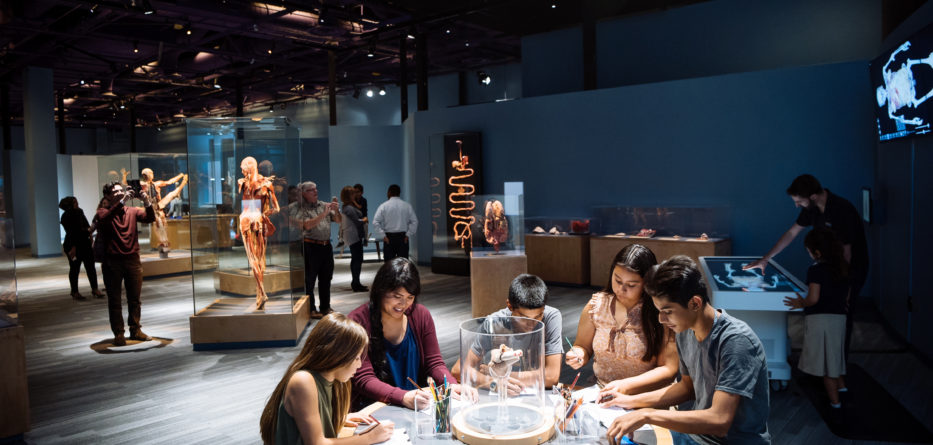The Tech Museum opens new permanent exhibit examining the human body, with unique and never before seen tech to amplify its effect
Arturo Hilario El Observador
The human body is a complex machine. Our windows to the world, our earthly vessel. To many, it’s common belief that our bodies are inhabited by our souls.
As a living, breathing machine, the human body is a testament to our evolution and survival on a physical level.
The mysteries of our physical selves have for the most part been unearthed and researched by physiologists, academics, anthropologists and the like, with the solution lying in medical advancements in technology and knowledge.
Now, if you’ve ever had questions about how exactly your body functions, or wanted to explore the different systems that make up your physical self, the Tech Museum in San José can help. It’s new permanent exhibit, Body Worlds Decoded, takes you into, out of, and through the human body with the help of new technology and at the center of it, the physical body itself.
On Sunday October 15th, the exhibit officially opened to the public, marking a step into the Museum’s plans for the future. As of now the Tech Museum has many attractions that are on the cusp of the latest technological advancements, being from Silicon Valley it’s expected right?
From total body virtual reality simulators, to Adobe technology that allows one to replicate the weight, feel and shine of oil paints on a digital canvas, Body Worlds Decoded just adds to that cutting-edge direction.
The Body Worlds Decoded exhibit takes inspiration and guidance from the original Body Worlds, a traveling exposition started in 1995 by Dr. Gunther von Hagens, who also happens to be the person who invented the plastination technique to preserve specimens in a way that replaces fat, water and cells with polymers like silicone rubber, polyester or epoxy resin. Dr. von Hagens wife, Dr. Angelina Whalley, is the curator and developer for the various exhibitions that travel the world. The combined attendance to all the Body Worlds collections has been 45 million visitors across 115 countries.
Through the sponsorship from Silicon Valley philanthropists Ann and John Doerr, the Tech Museum’s newest addition will be on display for the next decade, with the plan to update the augmented reality throughout.
Tech Bodies
The unique perspective that the Tech Museum adds is the augmented reality technology that brings another layer to the exhibit.
With the help of handheld tablets that sync up with the environment, the exhibit opens up even more opportunity to explore beyond the physical elements which are behind glass. It allows you to hold the tablet in front of you and see additional 3D models and information in various locations. In one instance, you can walk around a model of an eyeball. There are information bubbles you can click, and to top it off, you can walk behind the eyeball, and into it, to see through its iris.
At a special soft opening of the exhibit on Friday October 13th, Dr. Angelina Whalley was present to give her blessing of the Tech Museum’s take of the Body Worlds exhibition and all its new implementations. This being the first time she and her husband
let an external entity operate a Body Worlds exhibition, she said it was a difficult and unique situation to allow someone else to have a try at their creation.
“I’m in charge for the content and the development of Body Worlds exhibits since its very beginning, and I admit it took me quite some strength and patience to just pass it on to the museum. [To] let it go and to trust in the museums competence to make something very great,” said Dr. Whalley.
Her visit to the Tech proved to be positive, as her hopes were met, and even exceeded when she first toured the finished exhibit.
“When I arrived I realized, yes it was worth it. It is absolutely fascinating to see what the technology can do already today, and I understand it’s just the beginning, it will be developed over the next years to come and I will feel proud and honored. My husband, who is the inventor of the technology behind it, he will feel honored to be just a minor part of that.”
Decoding
As aforementioned, the Body Worlds Decoded exhibit includes many real, plasticated bodies, as well as close up views of muscles, joints, organ systems, and more.
Examples of the entire body and its various irregularities are present to show us what happens when certain parts are working as they should, or if they’re unhealthy, how that affects the system.
From head injuries like Chronic traumatic encephalopathy (CTE) to concussions, and diseases like cancer and cirrhosis of the liver, the exhibit shows you plain and simple, the very real harm that can happen to bodies.
A pair of lungs in one area of the exhibit shows the healthy, pink hued lungs of an adult on one side, and next to it the shrunken, blackened lungs of a smoker. This is as real and lifelike as technologically possible, and quite a sight to see.
But, most of the full bodies on display are remarkably poignant. They are in poses that focus on movement, muscle use and displacement of energy. A flamenco dancer striking a pose with her arms up and her chest out, a baseball player in full swing of a bat. The main takeaway is that the body is incredible in its abilities and stripping down to the muscle or even down to the cell level brings some of that usually unseen layers and process to the forefront.
After all, the mission of the Body Worlds exhibits is to be an educational tool. To show you, the visitor, what you’re made of, and to promote thoughts of healthy lifestyle and ultimately, could be seen as a suggestion to take care of your own “machine”.
As Dr. Whalley finalized her thoughts she mentioned the importance of our bodies.
“There’s one special wish I have, for Body Worlds Decoded. That [it] remains a reminder of who we are and what we are made of. Our body is already a fascinating and intricate machine, it is so complicated that any attempt to mimic it must fall short. We are not digital, we are analog. Our genetic makeup hasn’t changed much over the past 40,000 years, and our body has its very specific needs. It being the only true place we have to live. It is worth listening to it, to its needs, and take care of it.”
Body Worlds Decoded is open to the public with Tech Museum general admission now. Operating hours and more information can be found at thetech.org.






